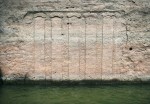 The head of a monumental Buddha statue has emerged from a reservoir in eastern China’s Jiangxi Province. When a hydropower gate renovation project dropped the water levels in Hongmen Reservoir 10 meters (33 feet) last month, local villages spotted the head in an alcove carved into the cliff face. A team of underwater archaeologists were dispatched by the State Administration of Cultural Heritage and the Jiangxi Provincial Research Institute of Archaeology to examine the carving.
The head of a monumental Buddha statue has emerged from a reservoir in eastern China’s Jiangxi Province. When a hydropower gate renovation project dropped the water levels in Hongmen Reservoir 10 meters (33 feet) last month, local villages spotted the head in an alcove carved into the cliff face. A team of underwater archaeologists were dispatched by the State Administration of Cultural Heritage and the Jiangxi Provincial Research Institute of Archaeology to examine the carving.
The initial investigation, concluded on January 15th, found the statue depicts the Gautama Buddha sitting on a lotus flower. It is 3.8 meters (12.5 feet) high and the style of carving, particularly the head shape, suggests it was made in the early Ming Dynasty (1368-1644), although it may edge over into the earlier Yuan Dynasty (1271-1368). Over the Buddha’s alcove two wide chevrons resembling the peaked roofs of temples were carved. A path, an inscription with 30 characters, and chisel marks were found to the north and south of the statue, respectively. There are also rectangular holes carved into the stone, the remnants of architectural features. Under the water in front the clifface with the statue divers found stonework from the foundations of hall a massive 165 square meters (1776 square feet) in area.
 Local records indicate the reservoir was built on the site of the ancient town of Xiaoshi. The underwater archaeology team came across its remains in the lake. In its heyday it was a thriving center of commerce, a hub for water transportation between Jiangxi and Fujian provinces, felicitously located at the intersection of two rivers. According to local lore, the Buddha was carved at that intersection to protect boats from the strong cross-currents.
Local records indicate the reservoir was built on the site of the ancient town of Xiaoshi. The underwater archaeology team came across its remains in the lake. In its heyday it was a thriving center of commerce, a hub for water transportation between Jiangxi and Fujian provinces, felicitously located at the intersection of two rivers. According to local lore, the Buddha was carved at that intersection to protect boats from the strong cross-currents.
It was submerged in 1958 when the reservoir was built. With no cultural patrimony protections in place to block the project and no practical way to recover or shield the temple, it was simply written off. That turned out to be a good thing, because benign neglect under a man-made lake sure beats the Cultural Revolution and the mass destruction of historic and religious heritage it spawned. The waters preserved the Buddha carving in very good condition, protecting it from weathering and pollution as well as human malice.
Many local residents were forced to move to make way for the new reservoir. Some have now come back to witness the reemergence of the Buddha.
Blacksmith Huang Keping, 82, used to live near the site.
“I went to the temple in 1952 and saw the Buddha statue for the first time. I remember the statue was gilded at that time,” said Huang.
He recalled that there was a small temple at the foot of the Buddha statue and many of the villagers held Buddhist beliefs.
The water levels will rise again in March with the annual spring flood. Everything now exposed will be submerged again. The archaeological team is working on a plan to protect the carving, temple and township remains. They also plan to expand their research into the area surrounding the lake temple.
This video has underwater footage of the Buddha statue. Visibility is poor and it’s hard to make out what you’re seeing other than stone parts.
[youtube=https://youtu.be/wI-006EWtOM&w=430]